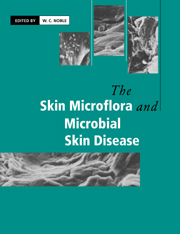Book contents
- Frontmatter
- Contents
- List of contributors
- Preface
- 1 The basis of the skin surface ecosystem
- 2 Nutrition of cutaneous resident microorganisms
- 3 Physical factors affecting the skin flora and skin disease
- 4 Coryneform bacteria
- 5 Coryneforms as pathogens
- 6 Staphylococci on the skin
- 7 Staphylococci as pathogens
- 8 Streptococci and the skin
- 9 Other cutaneous bacteria
- 10 Fungi and fungal infections of the skin
- 11 Bacterial and fungal skin disease in animals
- 12 Viral skin disease in man
- 13 Viral skin disease in animals
- 14 Microbial interactions on skin
- 15 Adherence of skin microorganisms and the development of skin flora from birth
- 16 Skin disinfection
- Index
4 - Coryneform bacteria
Published online by Cambridge University Press: 04 December 2009
- Frontmatter
- Contents
- List of contributors
- Preface
- 1 The basis of the skin surface ecosystem
- 2 Nutrition of cutaneous resident microorganisms
- 3 Physical factors affecting the skin flora and skin disease
- 4 Coryneform bacteria
- 5 Coryneforms as pathogens
- 6 Staphylococci on the skin
- 7 Staphylococci as pathogens
- 8 Streptococci and the skin
- 9 Other cutaneous bacteria
- 10 Fungi and fungal infections of the skin
- 11 Bacterial and fungal skin disease in animals
- 12 Viral skin disease in man
- 13 Viral skin disease in animals
- 14 Microbial interactions on skin
- 15 Adherence of skin microorganisms and the development of skin flora from birth
- 16 Skin disinfection
- Index
Summary
Coryneform bacteria include both aerobic and anaerobic, non-acid fast, nonbranching, pleomorphic, Gram-positive rods that do not form spores. Because of their similarity to the diphtheria bacillus, these organisms were formerly referred to as ‘diphtheroids’. They are commonly arrayed in palisades giving the appearance of Chinese lettering; cells vary from short, coccobacilli to long, bacillary forms and may be rod-shaped or club-shaped. Coryneform is thus a designation of a large, ill-defined group of bacteria. The diverse genera that have been included with the coryneforms include Actinomyces, Arachnia, Arcanobacterium, Arthobacter, Bacterionema, Bifidobacterium, Brevibacterium, Cellulomonas, Corynebacterium, Eyrsipelothrix, Eubacterium, Kurthia, Listeria, Mycobacterium, Nocardia, Oerskovia, Propionibacterium, Rhodococcus and Rothia.
Classification
In the past, coryneforms found on humans were assumed to belong to the genus ‘corynebacterium’. Attempts were made to construct taxonomic classifications through the use of various biochemical tests. During the past 20 years, important advances in methods for classifying bacteria have been developed, many of which have been applied to coryneforms. While this has led to clarification of their taxonomy, much further work is needed to establish agreed-upon species and their role in skin and systemic infections.
The early work of Somerville provided a classification scheme based on a battery of biochemical tests as well as other properties such as fluorescence under ultraviolet light, lipid requirement (lipophilia) and lipolysis. Other schemes, such as those of Evans and Marples, also used biochemical variables. In early studies of skin coryneforms, lipid dependency was a major feature of identification schemes.
- Type
- Chapter
- Information
- The Skin Microflora and Microbial Skin Disease , pp. 102 - 117Publisher: Cambridge University PressPrint publication year: 1993
- 3
- Cited by

